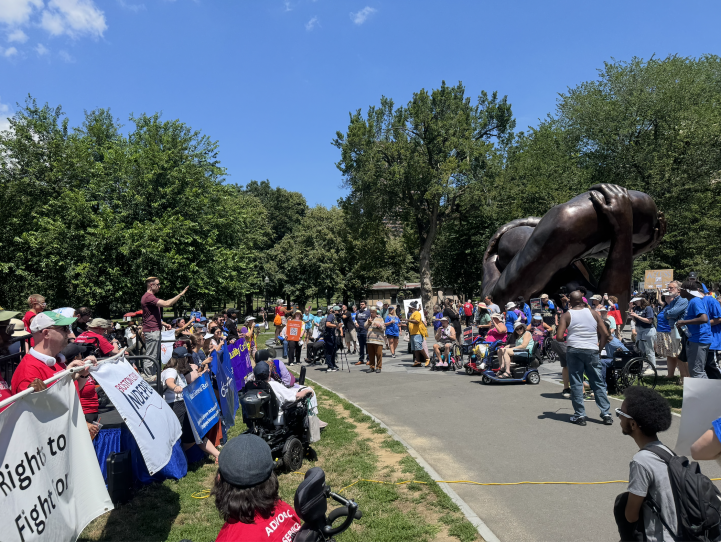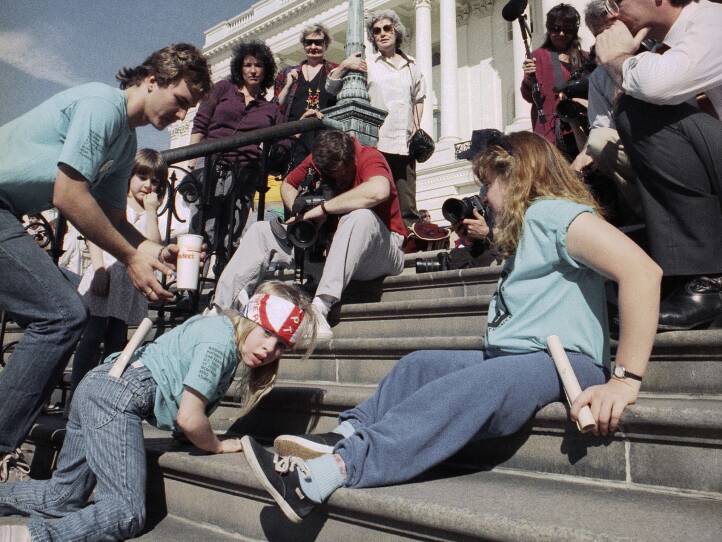Zary Amirhosseini came to the U.S. in 1979 when she was a child. Born in Iran with severe scoliosis, her family couldn’t find a specialist to perform the surgery she needed.
“A lot of people with disabilities travel to this country because of ... the rights, the accommodations, the resources that are available, the healthcare system that is available,” she said.
One of those resources is the Americans with Disabilities Act, which was signed into law by President George H. W. Bush on July 26, 1990, enshrining civil rights for people with disabilities.
Amirhosseini — who is now the manager of Massachusetts General Hospital’s disability program — and more than 1,000 other people marched and rolled through downtown Boston Wednesday to celebrate the 35th anniversary of the landmark legislation. The event started with the raising of an “ADA 35” flag at Boston City Hall and ended with a rally at The Embrace statue on Boston Common.
Many disability advocates say they are marking the anniversary with pride but also with trepidation, as policy changes at the federal level have caused concerns about the fate of programs they rely on.
Dianna Hu, chairwoman of the Boston Center for Independent Living, told the crowd that it has never been a more important time to protest. “Cuts to Medicaid could mean cuts to the Personal Care Attendant Program,” she said. “We deserve the right to live in our communities. When our dignity is on the line, we cannot be silent. We will not be silent, we will march on.”
Attendees also voiced worries about threats to DEI programs, educational resources for kids with disabilities in school, cuts to medical research and threats to immigrants who fill many caregiving jobs that make independence possible.
Before the march, Boston Disability Commissioner Kristen McCosh led a moment of silence for the 10 people who died in the recent fire at an assisted living facility in Fall River, who she considers part of the disability community.
“We know that 35 years after the ADA, we still have a lot of work to do, especially when it comes to housing and institutionalization of people with disabilities,” McCosh said.
‘Flourishing’ legislation
Lynn Miczek came to the rally to honor her late husband Jim. Before he passed away, she promised that she would continue advocating for disability rights. Jim became paralyzed in 1967, when life was different for people with disabilities.
“There were no curb cuts, there were no automatic doors,” Miczek said. “So a lot has happened, but I feel there’s still a lot more we need to do to make sure that people are able to live independently.”
The ADA prevents discrimination against people with disabilities in all parts of public life, including voting, employment, communication, transportation and more, ensuring accommodations like curb cuts, ramps, sign language interpreters and assistive technology.
There has been an “extraordinary” expansion of disability rights recently, said Steven Schwartz, an attorney at the Center for Public Representation. He points to legal victories such as the 2024 settlement of the Marsters case, which helps people avoid going to nursing facilities. Schwartz also noted innovations in adaptive technology and digital tools that have made the Internet more accessible than ever.
“The ADA, really, at least up to six months ago, was flourishing, expanding and making an exponentially greater difference, both to people with disabilities and to people without disabilities,” he said.

The ADA itself is not in danger and is “part of the fabric of our communities,” said Schwartz. But since President Donald Trump took office, there have been retreats in some aspects of the law, he said, and a “sea change” when it comes to enforcement.
He points to the repeal of DEI programs, and layoffs of people who worked in places like the civil rights division of the Department of Justice or the office in the Department of Transportation that would investigate complaints made by people with disabilities.
“It’s … a little disappointing and bittersweet that for the 35th anniversary we’re in a place of resistance rather than celebration,” Schwartz said. “But that’s where we are, and I think people are equally determined to resist as they would be to celebrate.”
Capitol Crawl and the next generation
Many of the people at the Boston rally noted that the community has a long history of advocating for their rights.
In March 1990, the ADA legislation was stalled in Congress. Dozens of people gathered on the steps of the Capitol to protest. About 40 of them set aside their mobility devices, canes, crutches and wheelchairs and climbed to the top of the 83 steps.

The protest was designed to get media attention and “to dramatize the inaccessibility of the built world,” said Holden resident Linda Belil, who set aside her crutches and climbed the steps that day.
Somerville resident Brian Shea, who has cerebral palsy, was 32 at the time.
“All I remember is handing my crutches to somebody and then ... doing the stairs,” Shea said. He and 103 protesters were later arrested at a sit-in in the Capitol Rotunda. He has no doubt that the activism helped the eventual passage of the ADA. “I would say to people, ‘Congratulations, you did this, you did this. We did this. This is ours.’”
Shea said it’s exciting to see the younger generation advocate and attend rallies like the one in Boston. “I love to see it,” he said.








